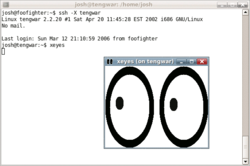Implementations

The X.Org implementation is the canonical implementation of X. Owing to liberal licensing, a number of variations, both free and open source and proprietary, have appeared. Commercial Unix vendors have tended to take the reference implementation and adapt it for their hardware, usually customizing it and adding proprietary extensions.
Up until 2004, XFree86 provided the most common X variant on free Unix-like systems. XFree86 started as a port of X to 386-compatible PCs and, by the end of the 1990s, had become the greatest source of technical innovation in X and the de facto standard of X development. Since 2004, however, the X.Org Server, a fork of XFree86, has become predominant.
While it is common to associate X with Unix, X servers also exist natively within other graphical environments. VMS Software Inc.'s OpenVMS operating system includes a version of X with Common Desktop Environment (CDE), known as DECwindows, as its standard desktop environment. Apple originally ported X to macOS in the form of X11.app, but that has been deprecated in favor of the XQuartz implementation. Third-party servers under Apple's older operating systems in the 1990s, System 7, and Mac OS 8 and 9, included Apple's MacX and White Pine Software's eXodus.
Microsoft Windows is not shipped with support for X, but many third-party implementations exist, as free and open source software such as Cygwin/X, and proprietary products such as Exceed, MKS X/Server, Reflection X, X-Win32 and Xming.
There are also Java implementations of X servers. WeirdX runs on any platform supporting Swing 1.1, and will run as an applet within most browsers. The Android X Server is an open source Java implementation that runs on Android devices.
When an operating system with a native windowing system hosts X in addition, the X system can either use its own normal desktop in a separate host window or it can run rootless, meaning the X desktop is hidden and the host windowing environment manages the geometry and appearance of the hosted X windows within the host screen.
X terminalsedit
An X terminal is a thin client that only runs an X server. This architecture became popular for building inexpensive terminal parks for many users to simultaneously use the same large computer server to execute application programs as clients of each user's X terminal. This use is very much aligned with the original intention of the MIT project.
X terminals explore the network (the local broadcast domain) using the X Display Manager Control Protocol to generate a list of available hosts that are allowed as clients. One of the client hosts should run an X display manager.
A limitation of X terminals and most thin clients is that they are not capable of any input or output other than the keyboard, mouse, and display. All relevant data is assumed to exist solely on the remote server, and the X terminal user has no methods available to save or load data from a local peripheral device.
Dedicated (hardware) X terminals have fallen out of use; a PC or modern thin client with an X server typically provides the same functionality at the same, or lower, cost.
Comments
Post a Comment